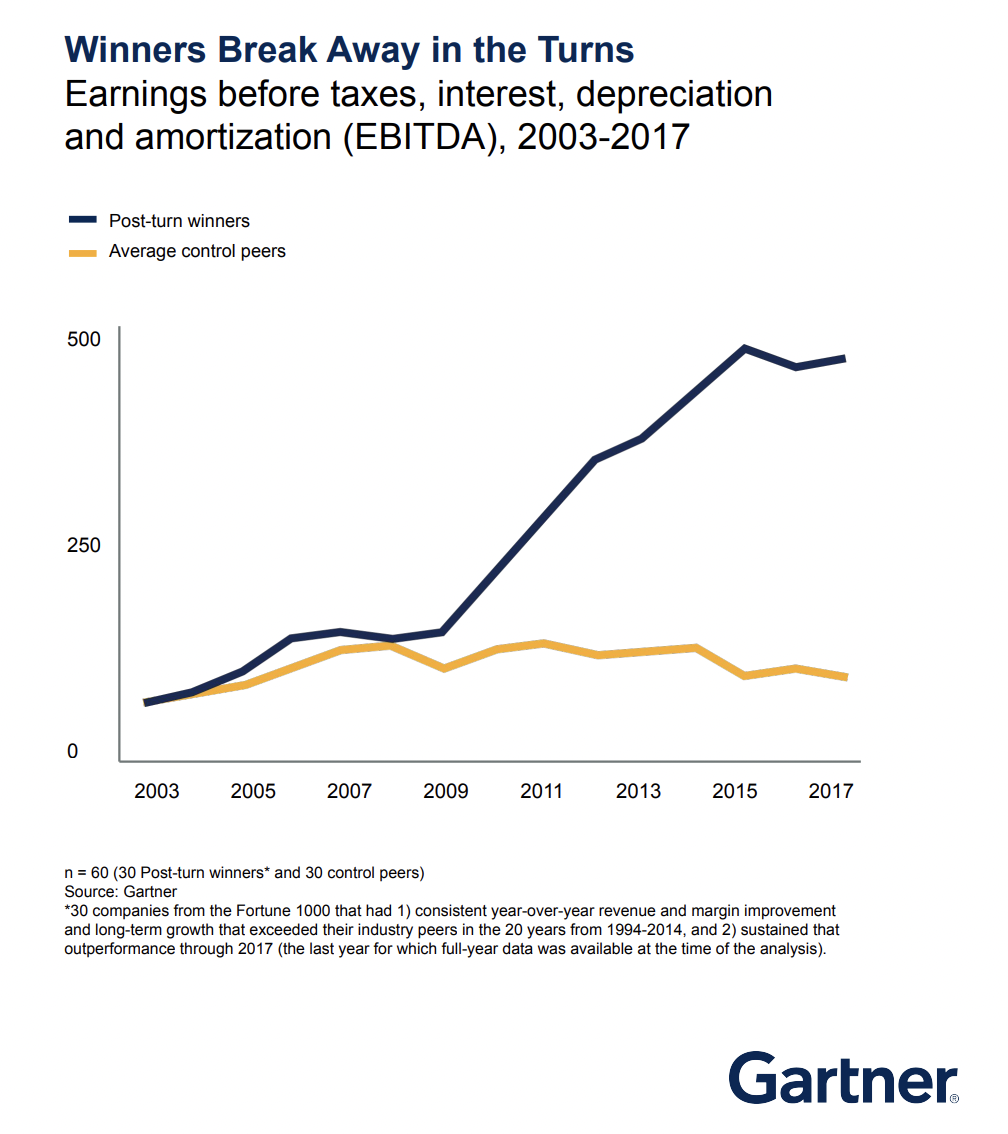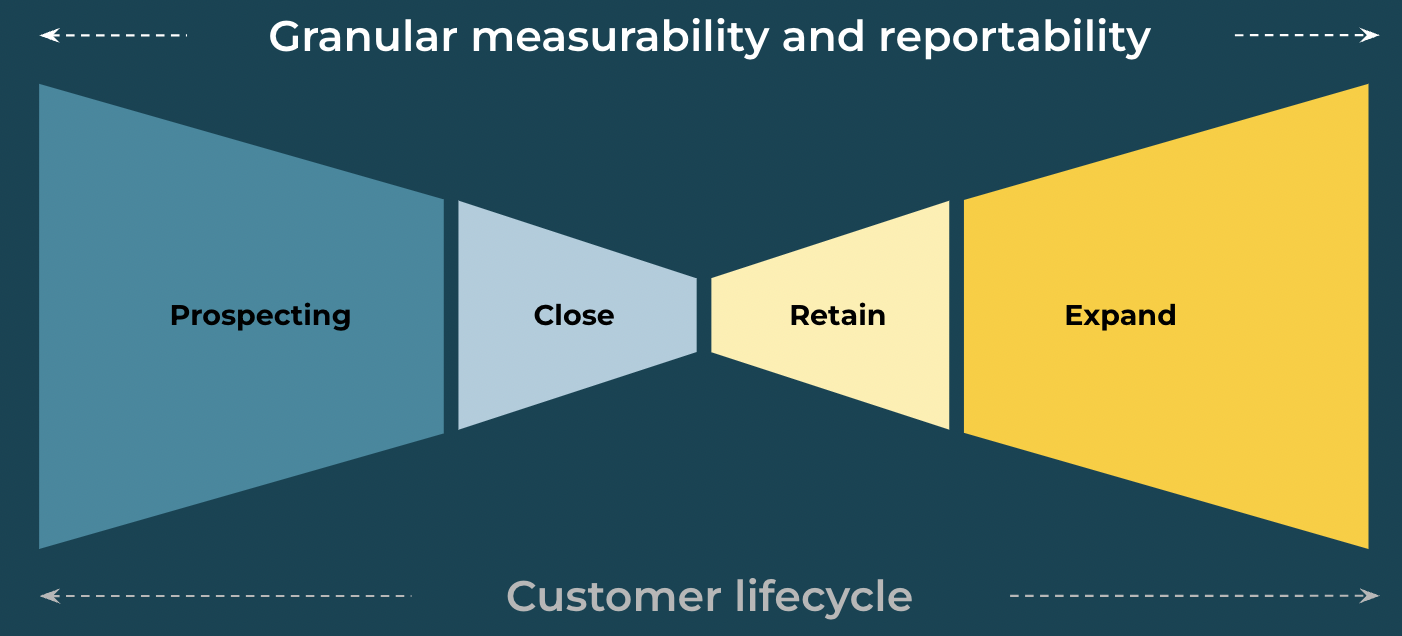So, we find ourselves once again in an economic downturn.
Cost-cutting initiatives are sweeping the tech sector as an immediate response to the threat of recession. Layoffs seem to be a part of most businesses’ contingency plan. (As of early August, more than 37,000 workers in the US tech sector have been laid off in mass job cuts so far in 2022.)
Elsewhere, companies are putting off hiring, stopping purchases of new tools, and generally making tech stacks leaner.
Are all these quick measures to conserve cash in an effort to build runway going to be worth it? Research says… probably not.
According to Gartner, focusing solely on cost-cutting has historically come at the expense of top-line growth. The companies that emerge victorious from uncertain economic climates are those that made a key pivot at the right time and emerged successful.

In order to be an outperformer in this downturn, your organization must make a pivot at the right time. The narrative has shifted from a “growth at all costs” model to “productivity at all costs”:
Instead of cutting deep on costs, leaders need to find ways to make their processes more efficient and their teams more productive.
Those who make a productivity pivot now will be more likely to survive not just this downturn, but also future uncertainties.
Activity data lies at the heart of making this goal achievable.
The narrative has shifted from a “growth at all costs” model to “productivity at all costs.”
RELATED: You’re going about rep productivity all wrong. Here’s how to fix it
The key to making the productivity pivot: Activity data
From here, I’m going to be focusing specifically on a major source of loss for most companies: revenue leak in the sales org.
If you’re not familiar with the term revenue leak, I like The Atlantic’s definition: It’s “the avoidable loss of revenue due to system failures in visibility, process, and execution.”
(And obviously, it’s bad.)
Enter activity data.
The first step to identifying sources of revenue leak in your sales org is looking at insights from sales activity data. This is data that reflects all the actions your sales team takes when interacting with prospects.
Activity data provides granular details that surface frictions in your sales process. These can get captured from sources like CRM, email, phone calls, meetings, calendars, or other tools.
For example, if the email velocity with a prospect suddenly drops, you can dig deeper to find the reason: Is the rep not being proactive with the account lately? Or is there a need to touch base with the prospect with a creative offer?
Insights from activity data address several such problems at its roots, and allow your teams to take real-time action to move opportunities forward.
This is all fairly obvious. Which raises the question — why aren’t organizations using activity data?
RELATED: 3 Tactics for Using Data to Boost Sales Engagement
Factors in the Great Revenue Disconnect
First, capturing activity data in an accurate and complete way in itself is an obstacle.
While 67% of businesses use between 4 and 10 digital tools, they don’t track the activity data generated from these tools in a complete and accurate manner. And as much as 79% of opportunity-related data collected by sales reps never make it to the CRM.
Second, data that does get captured in systems like CRM is not reliable.
CRM data is riddled with inefficiencies like outdated, missing, or incomplete entries. As many as 70% of revenue leaders are not confident in the accuracy of their CRM data. And such poor data quality costs organizations an average of $15 million per year.
Inaccurate and incomplete activity data in systems like CRM lead to teams that are misaligned in their tech stacks and goals. If your sales team is navigating issues like, Is the contact information related to the prospects updated? Are the email IDs in the CRM correct to begin with?, they’re not operating at max capacity.
And that poor alignment negatively impacts businesses and customers.
Without confidence in the data, sales and marketing teams are left to work in the dark. As a result, the ROI from huge investments like CRMs remains poor.
There are several such invisible leakages that keep happening throughout the go-to-market (GTM) funnel because of lack of good quality activity data and a unified visibility into them for the entire organization to refer to.
This causes The Great Revenue Disconnect: The torchbearer of revenue leakage across the organization.
Disconnected tools → Disconnected data → Disconnected teams → Disconnected insights
For businesses that are struggling during this downturn, lack of complete and accurate data can further exacerbate their problems. And immediate cost-cutting measures will fail to be the magic pill.
How does activity data address the Great Revenue Disconnect?
In the current market, clean and complete sales activity data is essential for making strategic decisions that drive visibility, productivity and predictability.
Visibility → Productivity → Predictability
Let’s look at how unified activity data capture and its insights can help your organization achieve sustainable revenue growth, not just for this downturn, but in any future, no matter how uncertain.
1. Activity data drives visibility across the organization
Visibility is the precursor to driving productivity. When your activity data is complete, you have greater visibility into what is going on within every deal, where the loopholes are that need fixing, and which deals require immediate attention.
Think deal reviews – an essential element of every successful sales process. With insights from unified activity data, deal reviews can transform ad-hoc events into powerful sessions where sales managers have clear visibility into the nuances of every deal.
With activities around every deal getting captured and updated automatically, managers don’t have to keep nudging reps to enter data into the CRM. Instead, both reps and managers can access full pipeline visibility of contacts and deal details, and focus on what demands immediate attention.
RELATED: How RevOps Can Use Sales Readiness Data for More Predictable Revenue Growth
Visibility through unified activity data capture aligns your entire go-to-market funnel. The entire organization can refer to a single source of data-driven insights and work together towards common goals.
For example, if a sales team notices that an important deal is stuck in the pipeline after a demo, they might want to share a specific case study to move it forward. They can work with marketing to get the most relevant document out and take the next step. And both teams can see the impact of their collaboration in the pipeline.
RELATED: 6 Change Management Hacks for Sales and Marketing Alignment that Lasts
2. Activity data makes your revenue teams productive & operational processes efficient
With activity data, you can map the productivity of your sales reps to their performance. For example, you can find answers to critical questions like:
- What are my reps spending time?
- When did we last do QBRs with our high-value customers?
- Are we talking to the decision maker or gatekeeper in the current quarter forecasted deals?
- Which of my reps are not following my best practices playbook?
- Are we going to hit our number?
- Which accounts did we touch last month?
- What happened to the leads marketing passed on to sales last week?
These insights give managers a view into leading indicators that can be used to give real-time coaching and make decisions based on activity data insights that move the needle.
For example, if a rep has pushed a deal to a close stage but there has been no activity in that deal in the last two weeks, the manager can immediately highlight this to the rep and mutually decide on the next steps.
3. Activity data helps you identify patterns and winning behaviors of your sales team
If a rep consistently hits their sales quota, what is their secret?
Behaviors that drive results can be emulated by the rest — if a high performing rep sends 50 emails a week, versus a low performing rep who only sends 15, maybe the latter can do better by improving their email cadence.
And behaviors that do not drive any results can be swapped with something that works. A head of revenue operations can identify those patterns and scale it up to the entire team.
It’s not just sales that benefits from activity data insights. For example, the Head of Customer Success can know how many managers are engaging with their accounts properly. With a fuller contact list, your customer success team can reduce churn by identifying and engaging more stakeholders in the buying committee beyond the champion.
4. Activity data drives a predictable revenue engine
A predictable revenue engine is the lifeblood of any successful business. This predictability is tied to your understanding of the habits and behaviors that drive the best results for your organization at large.
Activity data insights can help you drive those predictable patterns as you have clear visibility into your pipeline and the productivity levels of your GTM teams. Insights from complete and accurate activity data helps you:
- Have a predictable pipeline
- Have a predictable GTM team (sales, marketing, customer success)
- Know which activities drive results
- Know what to do each day to maximize productivity
By repeatedly doing more of what works, you can create a repeatable process for your teams. With a focus on leading indicators like how many emails to send each week, or how many demos to do each month, your teams keep striving to bring their best versions forward. And in case of any friction in the machine, you know exactly where to look and fix the issue.
RELATED: Sales Performance Dashboards to Keep Every Part of Your Revenue Engine on Track
Increased predictability leads to more accurate sales forecasts. This directly translates to better planning for next quarter and allocation of resources in a non-wasteful manner.

Make unified activity data your competitive differentiator
You cannot afford to work with bad data, especially in a downturn. Capturing complete and accurate revenue data is the key to successfully navigating this downturn.
The downturn is the equalizer that has forced revenue leaders to focus on the basics. Productivity is the differentiator. And unified activity data is the enabler.
Steer your ship forward this downturn with activity led GTM efforts. And make it your base for an iron-clad revenue strategy that can stand the test of time.
 Edited by Kendra Fortmeyer @ Sales Hacker 2022
Edited by Kendra Fortmeyer @ Sales Hacker 2022



